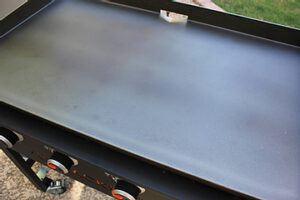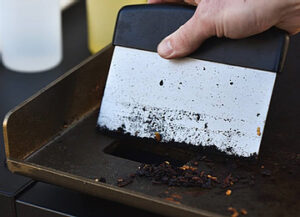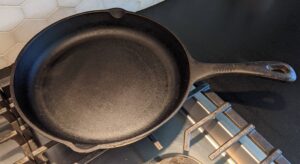If you purchased recently purchased a new Blackstone flat top grill (griddle) or are planning to, you’re going to need to know how to season a Blackstone griddle. This is an essential step that can’t be skipped, so make sure you know what seasoning is, why it’s important, and how to do it.
We’ll cover everything you need to know in this article, plus some common problems you may encounter and how to resolve them.
What is Seasoning?
Seasoning is a protective barrier on the cooking surface of your gas griddle that will combat rusting and extend the life of the flat top grill. It also creates a natural nonstick cooking surface helping prevent your food from sticking to the cooktop when cooking.
This protective coating is accomplished by baking oil onto the surface of the flat top grill. Seasoning is an ongoing process as a griddle owner rather than a one-time event. After the initial seasoning process, you’ll still need to maintain the seasoning over time.
The first time you season, it will take some time and require several applications of oil being cooked off, but the post-cooking maintenance will be much quicker and easier.
Why is Seasoning Necessary?
The importance of having a seasoned griddle is to protect the cooktop from unwanted moisture that could lead to rust or corrosion. If properly cared for, your flat top grill will last a long time.
A seasoned griddle will also prevent food from sticking by creating a nonstick surface to work with. There’s nothing worse than food getting stuck on the surface and having it fall apart as your cooking.
To protect your griddle and give yourself a trouble-free cooking experience, be sure to season it by following our detailed instructions below properly.
What Oil Should I Use?
This is a common and but also an excellent question. You have many options available, but certain oils will be better for this than others and some you’ll want to avoid completely.
Normally, when you are cooking on a griddle, you want to use oils with a high smoke point; however, you actually want the opposite when doing your initial seasoning. To create the protective layer from seasoning, you want the oil to smoke and cook-off. This is why an oil with a lower smoke point is preferable (though not required.)
You want to be sure and avoid any fats or oils that may have additives. As much as we love bacon around here, bacon grease doesn’t make for a good seasoning option because of things like salt, sugar, and preservatives that may be present.
Here’s a quick list of great options to season your griddle with the first time:
- Flax oil
- Vegetable oil
- Canola oil
- Olive oil
- Pure lard
- Blackstone griddle seasoning
Blackstone sells a griddle seasoning product which is a blend of a few different oils. This is an excellent option but also not necessary. You can accomplish an excellent seasoning with any pure cooking oil.
Seasoning Your Griddle the First Time
The first time you season your flat top grill is crucial and will take anywhere from 45 minutes to 1 hour and 15 minutes, depending on how many oil applications you decide to do.
What You’ll Need
You will need a handful of items to perform the seasoning. Here’s what you’ll need on hand:
- Water
- Dish soap
- Cooking oil
- Heat-resistant gloves or tongs
- Paper Towels
Step 1 – Clean
The first thing you need to do is clean the flat top cooking surface with some soapy water to remove any dust or dirt that may be present.

Using a paper towel, wipe down the cooktop with mild soap and water. Next, use water to remove any remaining soap residue and wipe the surface dry.
This should be the only time you use soap on your griddle. You will not use soap when cleaning it moving forward. This will strip away the seasoning you will have built up.
Step 2 – Heat
Now that you’ve cleaned the cooking surface, it’s time to turn on your flat top grill. Turn on all of the burners and set them to the highest heat setting. Allow the griddle to heat for approximately 10-15 minutes.

You will see the griddle top turning brown as it heats, but this is normal and expected. Once you have allowed it to heat for 10-15 minutes, shut off the burners.
Step 3 – Oil
Next, you’ll apply your first coating of oil to the cooktop. Drizzle some oil on the griddle (about 1-2 tablespoons) and spread it evenly across the entire surface and sides of the griddle top using paper towels and tongs or heat-resistant gloves.

Spread the oil evenly, and most importantly, make sure you apply a very thin layer. If there’s too much oil, it will lead to an uneven seasoning layer and result in flaking and chipping later.
When using the paper towels to apply the oil, imagine you’re trying to wipe all of it up. That way, you will ensure you’re applying a very thin coating.
Step 4 – Smoke
Now that you’ve applied your first coating turn all the burners back on to high. You will notice the oil begin to smoke, and the griddle top surface begins to darken even further.

This is creating the first of several seasoning layers protecting your griddle and developing the nonstick surface.
This process should take approximately 10-15 minutes to complete. Once smoke is no longer present, the bonding is complete. Doing just one layer is not sufficient, so don’t go anywhere just yet.
Step 5 – Repeat
To build up a sufficient seasoning on the griddle, you’ll need to repeat the process of applying thin layers of oil and allowing them to cook off several more times.
Repeat steps 3 and 4 of this process 3 to 5 more times until the cooktop surface reaches a dark brownish/black color. Ensure you continue to spread only a thin layer of the oil and fully cook off until no longer smoking each time.
Step 6 – Finish
Now that you’ve successfully created the protective seasoning layer on the surface, you’re almost finished. Turn off the burners and allow the griddle to cool off a bit. Once it’s no longer piping hot, apply one more coating of oil to the surface.

This last coating you do not want to have burned off, which is why you need to allow the griddle to cool off a bit. It’s good if the griddle is still warm but not so hot that it will be causing the oil to smoke.
This final coat you apply is to protect the griddle from rusting, and you’ll do this each time you finish cooking on it. Congratulations, you are now officially done with your initial seasoning and ready to start using your griddle!
Maintaining Your Griddle Seasoning
To maintain the protective coating and nonstick surface, you’ll always want to clean the cooktop and then apply a thin layer of oil after each cooking session.
What you’ll Need:
- Water
- Heat resistant gloves or tongs
- Cooking oil
- Paper towels
- Scraper or spatula
Step 1 – Clean
Set the burners to low and start by scraping the griddle surface using your scraper or spatula. Scrape all the remaining food bits and grease into the griddle’s grease trap. Squirt some water on as needed to help loosen any stuck-on food by steaming it.

Next, using heat-resistant gloves or tongs, wipe down the entire cooktop surface with paper towels or a cotton cloth. Once the surface is free of food and excess grease, you can proceed to the next step.
Step 2 – Oil
Now that the surface is clean, you’ll want to apply a thin layer of oil on the griddle cooktop. Take your cooking oil of choice and spread a very thin layer across the flat top using a paper towel or cotton cloth.
Use heat-resistant gloves or tongs for this step, and the griddle’s cooktop will still be very hot. Ensure you coat the entire surface and keep the layer of oil you’re applying very thin to prevent flaking. Turn off the griddle and allow the surface to cool.
Step 3 – Cover
To further protect your griddle, it’s strongly recommended you have a hard or soft cover and ideally both if possible. This will prevent dust and moisture from collecting on the griddle, which could cause rust or other damage.

The more you can avoid the elements getting to the cooktop, the better. If you can store your griddle in a shed, garage, or another covered area when you’re not using the griddle, I would definitely encourage this though it’s not a requirement if you have a cover for it.
Common Problems & FAQ
Even when following the proper processes to season and care for your griddle, you may still encounter some issues. Fortunately, it’s almost always fixable, but here’s a list of some common issues that can occur and how to address them.
Edges and Corners aren’t Black
Don’t be alarmed if, after your initial seasoning, the entire surface is not all black. You will likely notice some of the edges or corners being a lighter color, but that’s not a problem.
The heating elements don’t heat those areas quite as much, so they take longer to season. Just continue to apply oil before and after cooking, and it will even out over time. After a few cooking sessions on your griddle, it will be more uniform in color.
Brownish Substance or Black Flaking
If you notice a brownish substance or some black flaking on the cooktop’s surface, it’s not the end of the world and can be fixed. This is typically a result of leaving too much oil on the cooking surface after cooking.

If you encounter this, scrape off as much of the brown or black material as you can, and then clean and re-season your griddle top.
When applying a layer of oil, it doesn’t take very much, so don’t go crazy when applying it, and be sure to always wipe it down with a paper towel.
Food Sticking
The first few times you cook on your newly seasoned griddle, you may experience food sticking to your cooktop. That’s not abnormal and should correct itself as you continue to cook on it, and the seasoning continues to build up. Continue to oil the surface before and after cooking each time, and this should solve itself.

If you are experiencing sticking with a well-seasoned cooktop, you may need to use a little more oil when cooking. It’s okay to be liberal when putting down oil to cook with. This helps prevent sticking and also aids in the cooking of the food.
Rust
Even when taking the proper precautions, you may experience rust formation. If this happens, don’t throw out that griddle just yet, as this can be salvaged.

Check out our post on removing griddle rust for more information and a detailed breakdown on how to fix this.
Final Thoughts
Properly seasoning and maintaining your griddle season is essential to a great cooking experience on your flat top grill. If you care for your griddle properly, it will last a long time and result in some amazing food without a bunch of headaches. If it helps to see the seasoning process visually, check out Blackstone’s clip below for a video tutorial.
Check out our education section for more helpful griddle articles on Griddle Sizzle!




